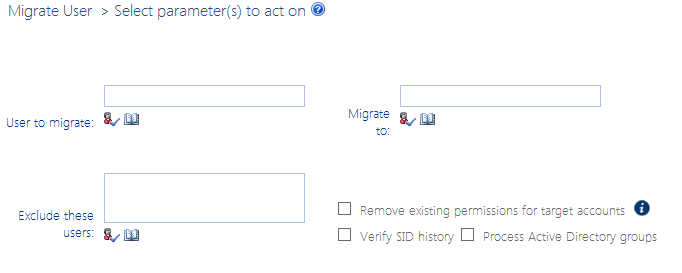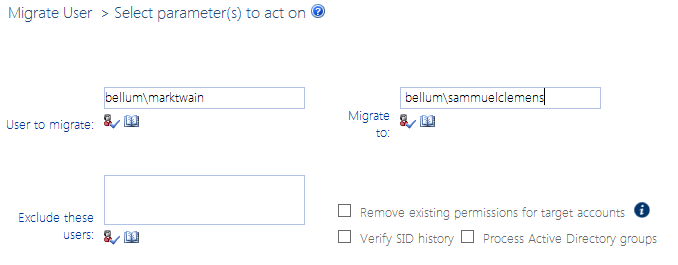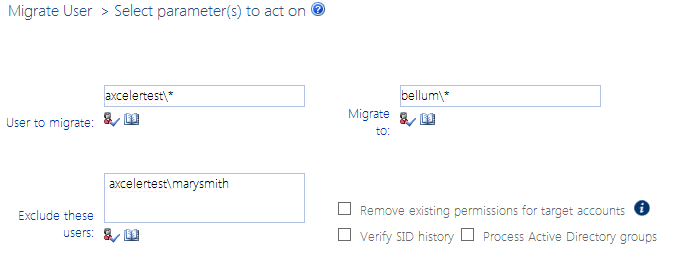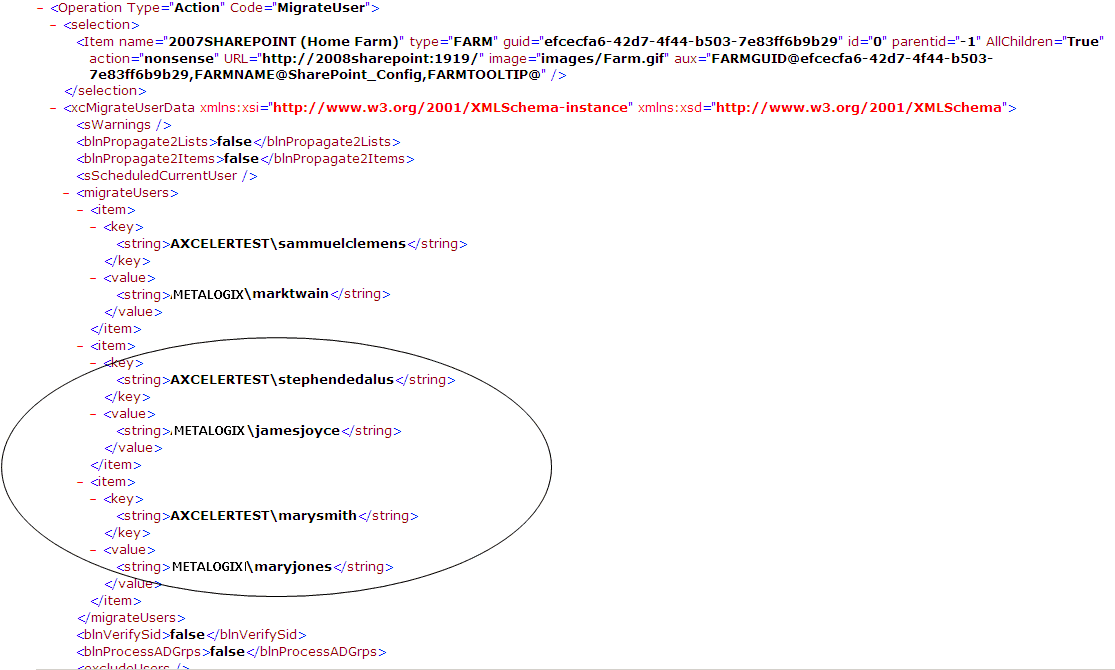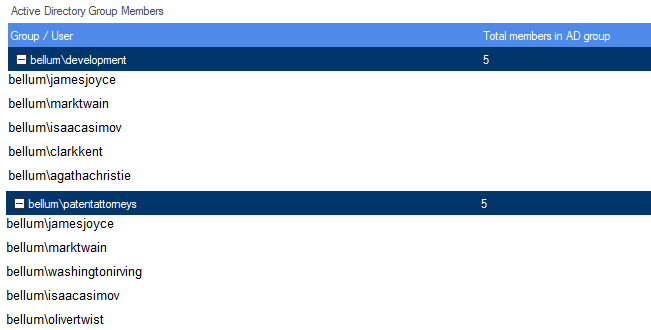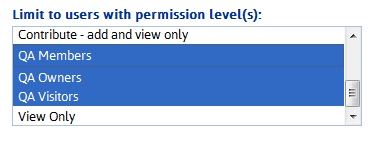Migrating Users
REMINDER: The Migrate Users action is not available for SharePoint 2013 or later farms.
Before carrying out the ControlPoint Migrate Users actions, it is recommended that you review Factors to Consider Before Using the ControlPoint Migrate Users Action.
To migrate users:
1From SharePoint Hierarchy farm node, choose Users and Security > Migrate Users.
2Check the appropriate option(s) using the information in the following table for guidance.
|
If ... |
Then ... |
|---|---|
|
·you have migrated users from one domain to another in a way that preserves SID history, and ·you want to verify the SID history to ensure that the old and new accounts correspond. |
check Verify SID history. REMINDER: ·For a simple account rename, leave this box unchecked because the same SID is used and a SID history is not generated. If this box is checked and a SID history does not exist, the operation will fail. ·In order to use the "Preserve SID History" flag, the ControlPoint Service Account must have dbowner rights to the User Profile Service Application Profile Database. |
|
you have migrated Active Directory groups from one domain to another and you want to update permissions granted to Active Directory groups |
check Process Active Directory groups. NOTE: if you leave this box unchecked, Active Directory group names will not be updated |
|
·you want to remove any permissions that have been granted to individual Active Directory user accounts at the target and replace them with the permissions from the source account (which is default stsadm -o migrateuser behavior) ·replace the permissions of Active Directory groups at the target with the permissions of corresponding source groups |
check Remove existing permissions for target accounts. NOTE: If you leave this box unchecked, the Migrate action will skip any individual Active Directory accounts that already have permissions. (Skipped accounts will be recorded in the ControlPoint Task Audit.) For Active Directory groups, the action will append permissions from the source group to any permissions that exist for the target group. The Migrate User operation only evaluates permissions collected during the last Discovery run. |
3For User to migrate, enter a single user name or wildcard.
Note that you can only enter one wildcard, anywhere within the entry.
REMINDER: When a wildcard is used, users are collected from the ControlPoint data cache, which is current as of the date and time of the last Discovery run.
EXAMPLES:
§In the following, we want all instances of the login name axcelertest\marktwain in our SharePoint farm to be changed to the new login name axcelertest\sammuelclemens. Note that Process Active Directory groups option is not relevant for this operation.
§In the following example, we want to change the domain for all users in our SharePoint farm from the old Active Directory domain (axcelertest) to the new domain (metalogixtest). We want to exclude axcelertest\marysmith from the process, because she was assigned a different account name in the new domain. The Process Active Directory groups option is checked, so that permissions of all Active Directory groups in the old domain will be transferred to corresponding Active Directory groups in the new domain. Remove existing permissions for target accounts is also checked, to ensure that any existing permissions for a target account will be replaced with those from the matching source account.
REMINDER: Once the operation is run, the old account will still exist in Active Directory, but will no longer have permissions in SharePoint.
Now you can:
·run the operation immediately (by clicking the [Run Now] button)
OR
·schedule the operation to run at a later time or on a recurring basis.
OR
·save the operation as XML Instructions that can be run at a later time.
If you chose to Save XML Instructions and want to specify additional users to migrate, enter each user as a separate item with:
·the old login name as a string between the <key></key> tags
·the new login name as a string between the <value></value> tags.
Data Analysis and Reporting
ControlPoint offers several advanced tools for analyzing data in the SharePoint environment, including:
·a summary of components and statistics at different levels of the SharePoint Hierarchy
·activity throughout the SharePoint farm
·storage used by various SharePoint objects
·site content
·information about users, including:
§permissions for Web applications, site collections, sites, and pages, and
§"orphaned" users, which are users who have permissions within SharePoint but are no longer listed in the Active Directory
·trends over a specified time period
·the contents of SharePoint audit and change logs.
An additional tool, the ControlPoint Task Audit, enable you to review ControlPoint actions taken by administrators.
Analysis tools are accessible for various levels of the hierarchy. As with other ControlPoint features, the scope of the analysis is determined by the hierarchical context.
Most analyses can also be configured so that they can be invoked directly from a url, which can be bookmarked, emailed, or placed on a SharePoint site.
NOTE: This chapter describes all of the ControlPoint analysis tools. Depending on the configuration of your ControlPoint menus, however, the analysis tools to which you have access, and their location in the menus invoked from the left navigation pane, may vary.
You can also create dashboards for monitoring key statistics within your farm.
Specifying Parameters for Your Analysis
When you select a ControlPoint analysis tool from the left navigation pane, you are prompted to specify the parameters you want to use. The most common parameters used in various ControlPoint analysis tools are described below.
Note that, depending on the analysis, some parameters may be located in the Advanced Parameters section.
Cached vs. Real-time Data
Some ControlPoint analyses give you the option of using either cached or real-time data for analyses performed on the farm, one or more Web applications, or site collections.
If the Use cached data box is checked, your analysis will include data that has been collected by ControlPoint during the last run of Discovery . The advantage of using cached data is that the analysis will be processed more quickly and will not compete for system resources. Because Full Discovery is run on a nightly basis, the use of cached data is often sufficient, especially when the analysis contains data that is not likely to change significantly over the course of a day.
The advantage of using real-time data (when the Use cached data box is unchecked) is that your analysis will contain the most current information. However, because the data is being captured in real time, the analysis will take longer to process and may tie up system resources.
IMPORTANT: For analyses performed on a single site collection or site, real-time data is always used and the Use cached data option is disabled. Because data collection within a single site collection or site is less time-consuming, the impact on system resources is minimal.
Specific Date or Time Period
For analyses that cover a specific time period, you select the time period by specifying a Start Date and End Date.
For analyses that involve activity, only cached data is used, since these analyses are based on accumulated summary data collected nightly by SharePoint usage analysis jobs.
For analyses involving other types of data (such as site collection storage) you are given the option of using real-time data.
IMPORTANT: Historical data that predates the ControlPoint cache will not be reflected in analysis results. For example, if the ControlPoint cache was created two weeks ago, a maximum of two weeks-worth of data is available for analysis, regardless of the date range you specify. Similarly, any historical data that postdates the last run of Discovery will not be reflected in results. For example, if you request data for a time period that covers the last 30 days and the last time Discovery ran was 10 days ago, analysis results will reflect the time period up to the last Discovery run date.
The format that ControlPoint uses to display dates is based on browser settings (rather than server settings). If you want to change the format (from mm/dd/yy to dd/mm/yy for example), go to Internet Options and change the Language Preference.
It is worth noting that deleted sites will display in activity and storage analysis results if they were active during the specified time period.
Open drill-down Options
For analyses that allow you to drill down to a more detailed ControlPoint analysis, you can choose to display it in a separate window by checking the Open drill-downs in new window box.
If you leave this box unchecked, the analysis to which you are drilling down will display in the current workspace, and parameters from the original analysis will be carried over. You can return to the original analysis by clicking the Back arrow in the report header.

Note that, when you link to a SharePoint page from analysis results, it always displays in a separate window.
Expanded Results Option
For most analyses that contain nested data, you have the option of choosing whether or not you want to display results expanded.
If you want to display results at the highest level of detail, uncheck the Display with results expanded box. You can then expand items individually, and view, print, or export additional detail for selected items only.
If your analysis contains a lot of nested data and you want to view, search, print, or export all of the analysis detail without drilling down, you may choose to have results display fully expanded by checking the Display with results expanded box .
TIP: If you choose to display expanded results and your analysis contains a large amount of data, you can use the Document Map to more easily navigate through results. See Analysis Results Display.
Additional Parameters for Permissions Analyses
The following parameters are specific to SharePoint user permissions analyses:
·If you want to limit results to one or more specific users, the Select users field allows you to select the users you want to include in your analysis. If you leave this field blank, all users will be included.
NOTE: You must use real-time (not cached) data if you are selecting users based on a SharePoint User Profile Property.
·If the scope of your analysis includes sites with multiple child objects, you can choose to display all objects (including those whose permissions are inherited) by unchecking the Show Unique Permissions Only box.
NOTE: If this option is checked, only sites with unique (non-inherited) permissions will be included in the results.
·If you want results to include only users who have direct permissions (that is, do not have permissions via a SharePoint group), check the Include only users with Direct permissions box.
TIP: You can use this option to identify "rogue users" who should have permissions through membership in a SharePoint group, then initiate an Add User to Groups action directly from analysis results. See Acting on Search or Data Analysis Results.
·If your selection includes Active Directory groups and you are running the analysis using real-time data:
§ You can include separate line items for users who have permissions through those groups by checking the Include users with AD group membership box.

If you leave this box unchecked, only the permissions of the AD group itself (not the users within it) will be included in analysis results.
§You can include a summary section at the end of the analysis that lists the Active Directory groups within the scope of your analysis along with all of their members by checking the Include AD Group Members table box.
NOTE: You cannot display membership in Active Directory groups if you are running the analysis on cached data (and the checkbox will be disabled). If the ControlPoint Application Administrator has configured the application to prevent members of Active Directory groups from being displayed, this option will not be visible. Built-in groups (such as authenticated users) are not counted.
·If you want to limit results to one or more specific permissions levels, select them from the Limit to Users with permissions level(s) list box. (All built-in and custom permissions levels that are currently assigned to at least one user on at least one site within the scope of your analysis display in the this box.)
If the analyses includes lists and/or items, permissions levels that are assigned to a list/item that are not assigned at the site level will not display in the list box. (The list box is populated by data collected by the ControlPoint Discovery process, which does not go below the site level.) A list- or item-level permissions level can, however, be entered in the Limit by Other Levels field.

·If you want results to include only sites for which anonymous access is allowed, check the Show Anonymous Access Only box.

·If you want a cumulative total of unique users who have permissions for objects within the selected scope, check the Calculate Total Users with Permissions box.
Total Users with Permissions includes:
§Web application Service Accounts
§Users granted permissions through Web application policies
§Site Collection Administrators
§Users within Active Directory groups to which the ControlPoint Service Account has access (that is, within the same domain or forest, in a different domain/forest for which with a two-way trust exists, or in a different domain/forest with a one-way outgoing trust that ControlPoint can authenticate via the ControlPoint Manage Forest Access feature). Disabled Active Directory accounts are included in this total. If an Active Directory user has been renamed but still has permissions in SharePoint under the old name, each name will be counted as a separate user.
Excluded from this total are built-in groups and special accounts, such as nt authority\authenticated users (or any account that begins with "nt authority") and sharepoint\system, and users granted permissions via augmented Claims or alternate authentication providers.
NOTE: If you choose to run the analysis using cached data, Total Users with Permissions uses data recorded in the ControlPoint Administration Database (xcadmin), and is current as of the last Discovery run. (The actual number of users within Active Directory groups are always counted in real-time, however.) If you run the analysis using real-time data, all users are counted in real time, which may significantly increase the amount of time it takes to run the analysis.
Analysis Results Display
All ControlPoint analysis results displays include a standard header and footer, in addition to analysis-specific detail.
Analysis Results Toolbar
ControlPoint analysis results pages include a toolbar which contains page navigation, export, and print capabilities.
Above the toolbar are links that enable you to:
·select all objects in analysis results to include in a ControlPoint operation
·download results as a CSV file
Analysis Results Detail
The analysis results detail sections contains summary information, followed by the analysis-specific content.
The summary section includes the parameters used, as well as the name of the user who ran the analysis and the run date and time.
Note that, if the analysis was run using cached data, the date and time that the cache was last refreshed via the Discovery task displays. The information in the analysis is current as of that date and time. If the analysis was run on real-time data, the Cached field will be populated by the value "False."
You can sort line items in analysis detail for any column that includes an up/down arrow.
Analysis Results Footer Information
The analysis footer, which appears on every page of the results, contains the following information:
·the name of the administrator who generated the analysis (which can be useful if results are exported or printed and distributed, since the content of the analysis reflects that administrator's permissions)
·the number of pages in the analysis (you can scroll through multi-page results from the navigation toolbar in the search results header), and
·the date and time when the results were generated.
Selection Summary
The Selection table is repeated at the end of the Results section. This information is included in printed or exported results, as a helpful reminder of the item(s) included in your analysis.

